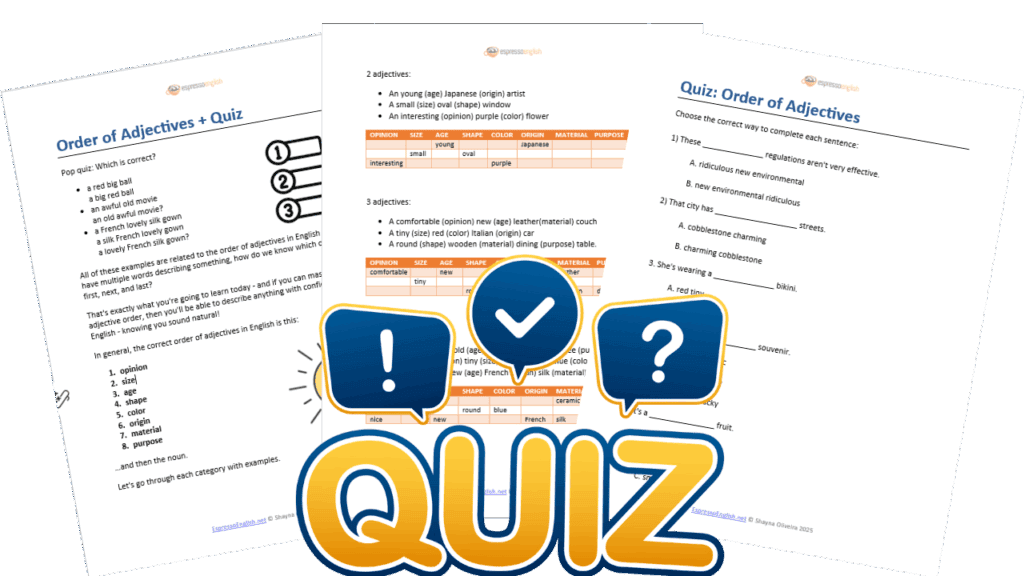
One of the easiest ways to identify a non-native English speaker is by the incorrect order of adjectives in a sentence.
For example:
- A red big ball – INCORRECT
- A big red ball – CORRECT
- A velvet new comfortable dress – INCORRECT
- A comfortable new velvet dress – CORRECT
- An old ceramic lovely coffee mug – INCORRECT
- A lovely old ceramic coffee mug – CORRECT
When we have multiple words describing something, how do we know which one comes first, next, and last?
That’s exactly what you’re going to learn today – and if you can master the correct order of adjectives, then you’ll be able to describe anything with confidence in English – knowing you sound natural!
Make sure to download the free PDF of this lesson – it’s a fantastic reference because it has LOTS of example words, as well as a quiz to help you practice the proper order of adjectives.
In general, the correct order of adjectives in English is:
|
1 |
2 |
3 |
4 |
5 |
6 |
7 |
8 |
|
Opinion |
Size |
Age |
Shape |
Color |
Nationality/Origin |
Material |
Purpose |
Note: Not everyone agrees on this order of adjectives, and there may be exceptions
It’s rare to use more than 3 adjectives. But the adjectives you do use should follow this order:
- A big (size) red (color) ball
- A comfortable (opinion) new (age) velvet (material) dress
- A lovely (opinion) old (age) ceramic (material) coffee (purpose) mug
Here are some examples of each type of adjective:
Opinion Adjectives
- good / bad / great / terrible
- beautiful / pretty / sexy / comfortable
- ugly / awful / strange / uncomfortable
- delicious / disgusting / tasty / nasty
- important / excellent / wonderful / brilliant
- funny / interesting / boring
General Size Adjectives
- big / huge / tall / long / enormous / gigantic
- small / little / tiny / short / minuscule
Age Adjectives
- old / ancient
- new / young
Shape Adjectives
- Round / square / triangular / rectangular / flat
Color Adjectives
- Red, blue, yellow, etc.
Nationality/Origin Adjectives
- Italian, Japanese, Thai, German, French, etc.
Remember – country/nationality adjectives are always capitalized!
Material Adjectives
- Gold, silver, copper
- Cotton, leather, polyester, wool, silk, velvet, nylon
- Wooden, stone, diamond, plastic
Purpose Adjectives
“Purpose adjectives” are almost like part of the noun. They describe what the object is used for:
- running shoes
- a sleeping bag
- a flower vase
- a frying pan
- a tennis racket
How Many Adjectives?
Note that it’s very rare to use more than 3 adjectives at a time. So although I could say “this is a useful big new square gray American plastic storage box” – nobody would actually say all of that, it’s unnatural. It’s more common to use just 2-3 adjectives, and they should follow the order. For example:
2 adjectives:
- An young (age) Japanese (origin) artist
- A small (size) oval (shape) window
- An interesting (opinion) purple (color) flower
3 adjectives:
- A comfortable (opinion) new (age) leather (material) couch
- A tiny (size) red (color) Italian (origin) car
- A round (shape) wooden (material) dining (purpose) table.
4 adjectives:
- A lovely (opinion) old (age) ceramic (material) coffee (purpose) mug
- A beautiful (opinion) tiny (size) round (shape) blue (color) jewel
Other Adjectives
There are other adjectives that don’t fall into the categories above. For these, the essential rule to remember is that opinion adjectives always come before fact adjectives (appearance and other “descriptive” adjectives):
- delicious (opinion) organic (fact) food
- crazy (opinion) religious (fact) people
- interesting (opinion) cultural (fact) traditions
- confusing (opinion) financial (fact) data
How to Learn the Correct Order of Adjectives
Although studying the order of adjectives in English can help… there reaches a point where you’ll learn them best simply by seeing and hearing them in action.
Most native English speakers don’t know the rules of adjective order at all – we just know that it “sounds right” to say “the big red ball” and “sounds wrong” to say “the red big ball.”
As you read and listen to more English, you’ll eventually begin to order the adjectives naturally. You can build your vocabulary further with these powerful adjectives, extreme adjectives, and negative adjectives. And definitely make sure you know these 100 common adjectives.
But for now, you can try this quiz to practice the correct order of adjectives in English!
Quiz: Adjective Order in English
Question 1 |
A | little fascinating |
B | fascinating little |
Question 2 |
A | overpriced Italian food |
B | Italian overpriced food |
Question 3 |
A | enormous old |
B | old enormous |
Question 4 |
A | tiny red bikini |
B | red tiny bikini |
Question 5 |
A | new environmental ridiculous |
B | ridiculous new environmental |
Question 6 |
A | blue plastic tacky |
B | tacky blue plastic |
Question 7 |
A | wonderful new sports program |
B | new wonderful sports program |
Question 8 |
A | round, purple, small fruit |
B | small, round, purple fruit |
Question 9 |
A | charming cobblestone streets |
B | cobblestone charming streets |
Question 10 |
A | Australian important politician |
B | important Australian politician |









